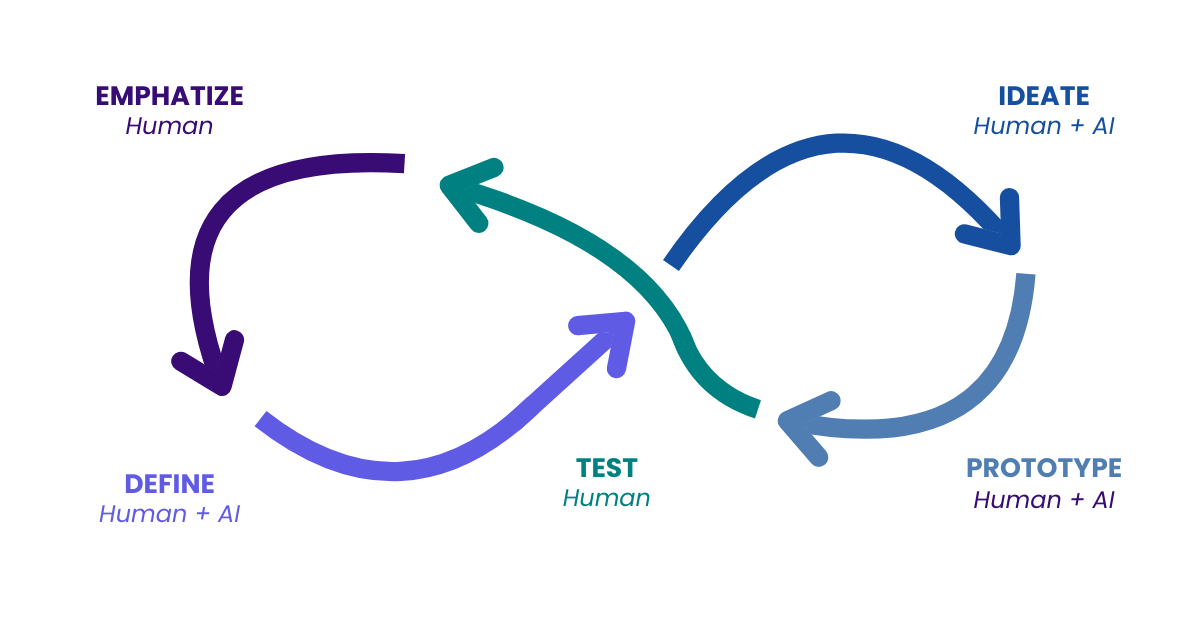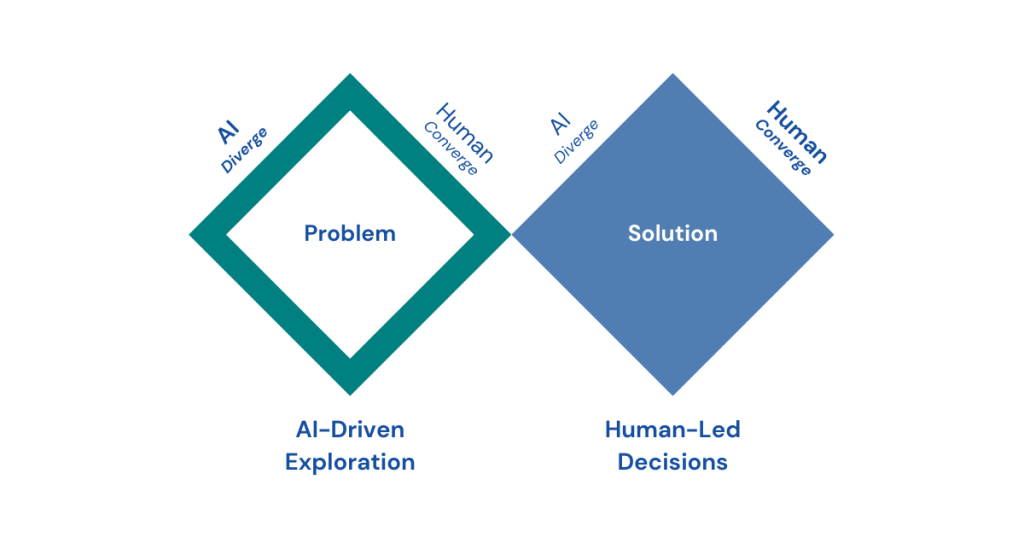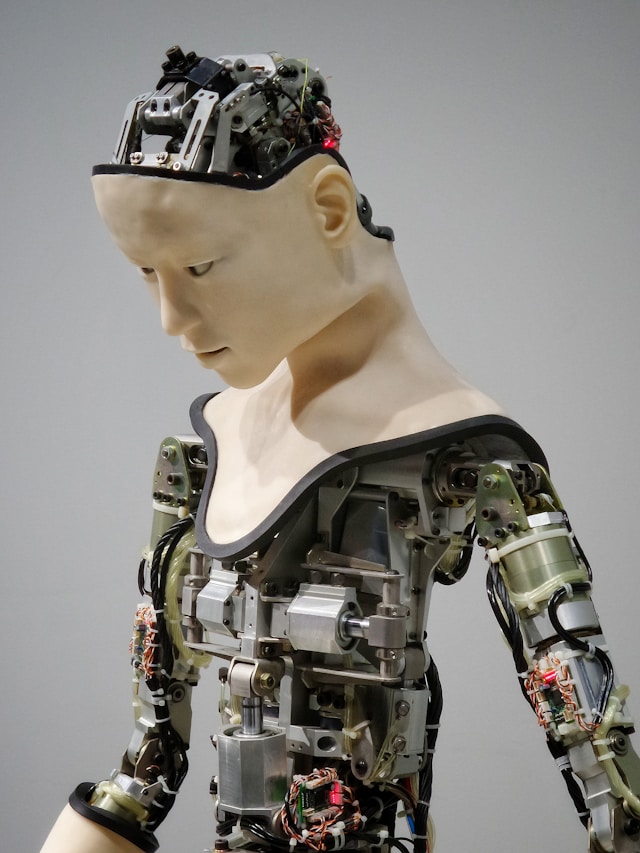In an era where artificial intelligence can rapidly accelerate everything from data analysis to creative ideation, many organizations jump straight into “tech-first” projects. Yet technology alone doesn’t guarantee relevance. Design thinking—a structured, human-centered approach to innovation—provides a crucial balance by focusing on real user needs at every stage. By combining the creative power of AI with the empathy and ethical judgment of human teams, businesses can tackle complex problems without losing sight of what truly matters to people.
A Brief Look at Design Thinking
Design thinking, as popularized by the likes of IDEO and the Stanford d.school, breaks down into five iterative phases: Empathize, Define, Ideate, Prototype, and Test. Although these steps can happen in a non-linear fashion, they serve as signposts that keep teams centered on user needs rather than rushing to build solutions.

- Empathize – Understand your audience’s experiences, motivations, and pain points through genuine, human conversations.
- Define – Combine your insights into a clear problem statement that tackles the core need.
- Ideate – Explore numerous possible solutions (even the wild ones).
- Prototype – Transform selected ideas into tangible artifacts (mockups, simulations, or minimal viable products).
- Test – Validate these prototypes by observing and conversing with real users, then refine accordingly.
While AI can drastically reduce the time spent on certain tasks, the core of design thinking is still grounded in empathizing with real people. Let’s look at each phase more closely—and see where AI genuinely helps or, in some cases, simply doesn’t belong.
The Design Thinking Process: Human First, AI Second
How do we put design thinking into action? Keep in mind that in practice, you may loop back and repeat stages as new insights emerge – and that’s expected. Let’s walk through the five steps:
Empathize: Interviewing Real People (No AI Needed—Mostly)

The first phase, Empathize, is fundamentally about connecting with people to grasp how they see the world. This requires immersion in real user interviews, observations, and experiences. Because empathy involves subtle social cues—facial expressions, tone of voice, or emotional context—no AI can replace the act of talking directly to people about their challenges.
However, if you’re preparing to interview large numbers of users, an AI tool can help you brainstorm potential interview questions. For instance, you might prompt a language model with: “Suggest 10 probing questions to learn about a busy parent’s daily struggles with after-school activities.” Though AI can be useful for generating ideas, you, as the human, remain responsible for customizing these questions to fit each user’s unique context and for maintaining a genuine rapport during interviews. This personal engagement uncovers nuances that purely digital tools typically miss—like frustration in a user’s voice or excitement in their facial expression.
Define: Narrowing Down the Real Problem

After gathering insights, the Define phase involves synthesizing your findings into a clear problem statement. Perhaps you discovered that busy parents aren’t just frustrated with scheduling—they’re anxious about safety or emotional well-being.
The question becomes: Which of these issues is the real priority?
Here, AI can help diverge on possible problem framings—by clustering your interview transcripts or sorting recurring user statements. That often sparks new angles you hadn’t considered. But the process of converging on the most important problem to solve remains a deeply human choice, tied to ethical considerations, company values, and the team’s intuitive grasp of user needs. As a design thinking maxim goes: “We can’t solve the wrong problem brilliantly.” Human judgment ensures you’re focusing on a challenge that truly matters.
Ideate: Generating Solutions, Hand in Hand with AI
Design thinking then invites teams to ideate broadly. This is where AI’s ability to quickly generate a multitude of ideas can turbocharge brainstorming sessions. You might ask an AI platform: “Propose 15 creative ways to streamline after-school pickups.” Some suggestions may be utterly impractical, but others might spark interesting hybrids your team wouldn’t have considered alone.

Still, it’s the human contributors who select, refine, and combine ideas into cohesive concepts. Empathy plays a vital role here—an AI might overlook cultural contexts or user sensitivities. For instance, it might suggest location-tracking features that feel invasive to some parents. Only humans can weigh those ethical or emotional factors effectively. This constant dance between AI’s divergence (producing a wide swath of ideas) and human convergence (merging the best proposals) characterizes ideation in an AI-enhanced environment.
Prototype: Accelerating Tangible Experiments
Design thinkers know that tangible prototypes are essential for collecting real-world feedback. Here, AI excels at expediting the “grunt work.” Tools can generate initial wireframes or even functional code in a fraction of the time it might take a human team. For instance, you could give an AI design assistant a description of an interface—“A dashboard to track multiple kids’ schedules, side by side, with simple color coding”—and quickly produce a draft layout.

Though AI can streamline these steps, the human touch ensures your prototypes align with your brand, values, and the actual emotional journey of your users. A glossy, AI-generated interface means nothing if it ignores the genuine pain points you uncovered during Empathize. Hence the best prototypes mix AI’s speed with your own knowledge of what resonates with real people.
Test: Human Conversations Close the Loop

Finally, testing your prototypes with real users is the culmination of design thinking. It’s also where empathy comes full circle—watching someone struggle with or delight in your prototype reveals insights that raw metrics alone can’t fully convey. AI can certainly track user actions or identify patterns in feedback forms, but interpreting subtle emotional or environmental factors is something only a person can do well.
In other words, the real measure of success is how actual humans respond—and that’s a conversation that goes beyond data sets and algorithms. If a solution fails, teams circle back to refine (or even redefine) the problem statement. Meanwhile, if the tests confirm your idea works, you have stronger evidence that it aligns with real user needs.
Diverging and Converging with AI
A key element of design thinking, often visualized by the Double Diamond model, consists of two main phases: one for expanding your understanding (divergent thinking) and one for focusing on the right solution (convergent thinking).

AI greatly amplifies this divergent capacity by producing more alternatives—be it potential problems to tackle or solutions to explore—than a typical human-only brainstorm might yield. Yet, convergent stages still depend heavily on human discernment. You might feed data into an AI to evaluate feasibility or cost implications, but deciding what best aligns with your organization’s culture, brand, and ethical standards remains a people-driven process.
Co-Intelligence: Working With AI, Not Against It
This blend of human empathy and AI-driven amplification is sometimes called “co-intelligence,” a term popularized by professor Ethan Mollick. Rather than viewing AI as a threat to creativity, co-intelligence treats the technology as a collaborative partner. AI’s near-infinite memory and capacity for pattern recognition complement the human strengths of empathy, ethical reasoning, and original insight. By intentionally uniting both, organizations can reach solutions that might otherwise be out of reach.
Integrating AI into the Process: A Balanced Approach
Rather than repeating “human vs. AI” for every step, it can help to think of three types of tasks:
- Human-Exclusive Tasks – Activities that demand personal interaction and emotional intelligence (e.g., user interviews, final ethical judgments).
- Human + AI Collaboration – Co-intelligent efforts where the machine provides speed, scale, or breadth of ideas, while humans refine and decide (e.g., ideation, prototyping assistance).
- AI-Driven Automation – Routine or highly repetitive functions (like sending out standard surveys, basic data cleanup) that can often run without requiring continuous oversight.
In practice, every organization finds its own balance. Some rely heavily on AI for rapid prototyping; others only bring it in during the ideation phase. The overarching principle is “human-centered but AI-augmented.” That means keeping people’s needs and ethical considerations at the forefront while letting technology handle tasks that machines do faster or more accurately.
Conclusion: Human-Centered, AI-Augmented
When leveraged thoughtfully, AI can dramatically enhance how we do design thinking—shortening the time between ideas and prototypes, expanding the pool of creative possibilities, and quickly synthesizing large volumes of user data. Yet the soul of design thinking remains human-centered empathy: talking directly to people, understanding their feelings and struggles, and making sure each step aligns with real human experiences.
In an age of rapidly evolving technologies, this combination of human insight and AI efficiency—sometimes referred to as co-intelligence—may become the defining advantage for innovators who want to solve complex challenges without losing sight of what truly matters. The best outcomes arise from nurturing empathy in parallel with harnessing AI’s strengths. That means building solutions that are desirable, feasible, and viable, while never forgetting that actual people stand at the heart of every problem worth solving.
At Predictive Systems Inc., we view AI as a collaborative partner, empowering our human teams to deliver innovative solutions that truly matter. Together, empathy-driven design thinking and AI create a powerful innovation engine capable of shaping the future.
Ready to innovate with AI-enhanced design thinking? Connect with us and let’s shape the future together.


